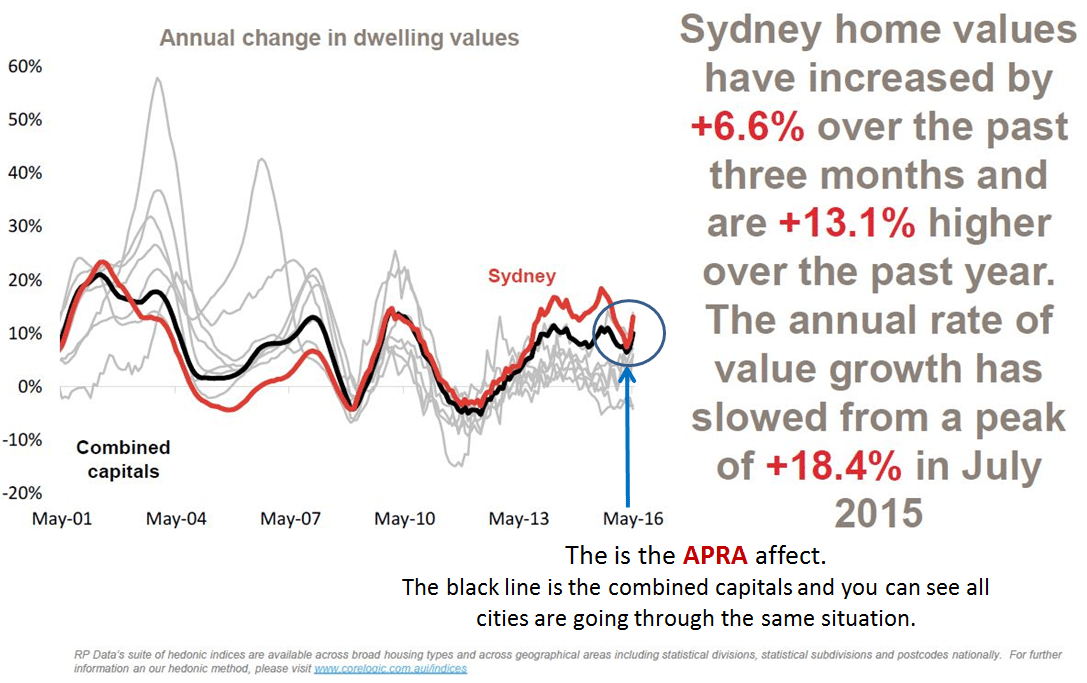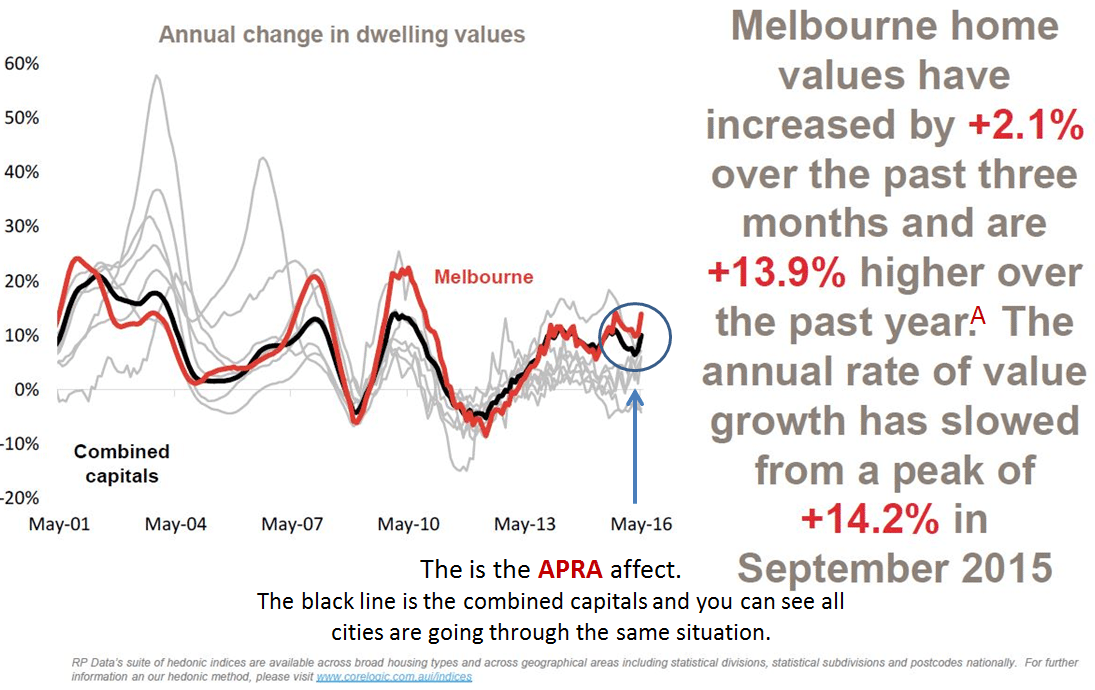
- 16 Jul, 2016
The APRA Effect
There is a lot of comment in the media on the so called property "boom". All these commentators lack long term experience in property and most are feverish supporters of the share market. They show an appalling ignorance of the property market.
Wayne Byers, Chairman of APRA used these misinformed journalists to throw red tape around the property investor market. He has squeezed property investors out of property. This squeezed supply out of the market. Eighteen months ago we predicted the squeezing of supply would lead to "APRA inflation". We predicted this property jump would be right around all the markets in Australia. This has happened and the chart below clearly shows the APRA effect.
In contrast to Byers’ aim of reducing prices, however you can see that Byers has increased prices.
Price is set by the law of supply versus demand.
Why don't journalists and bureaucracy look at this basic law when they are talking about alleged "booms"?. On our chart you can see the lack of supply and the increasing demand pushed Sydney and Melbourne prices high in 2001 - 2004. You can see this boom was higher than the current one that caused so much hysteria. Now, Chinese low interest rates are blamed by the uneducated journalist as the current cause of our boom. Back in 2001 - 2004 there were no Chinese influences but the prices were higher. There were no low rates then but the prices went higher. It's simply market forces. In 2005 the high prices encouraged a lot of supply that came onto the market, which resulted in price rises being slowly diminished; indeed in the next five years was very little growth in Sydney. From 2010 we put Researchers into the Sydney market saying that its sleepy period would soon finish.
As the chart clearly shows, increasing supply saw the market slowly correct. You could see that this was starting to happen but suddenly there was an upwards spike - prices started increasing. "This is the APRA effect", the property price inflation that we predicted.


The Prediction
APRA's madness will soon be unwound and normality will return to the market. This will see an up-tick in new construction which of course APRA has learnt comes from property investors. APRA has learnt that owner occupiers and first home buyers don't fund new construction that may take a year or two to be completed. Property investors are needed for this.
Containing future price growth
I promised some weeks ago that I would give you my solution. It's not more red tape but less. It’s not interfering with the supply but encouraging it. Currently, new construction is a rich source of tax income for local, state and federal governments. This means a new property investor paying $500,000 for a property is in reality paying $200,000 in government greed.
The solution
My solution is to remove a lot of these costs from the builder in return for reducing his price. Competition in the market place will ensure this happens. But it will be legislated for. The solution is simply to repeat history. Currently the builder has to borrow at increasingly high rates to pay for power, water, sewerage, roads (curbing and channeling), council contributions, parks and levees etc. Builders have to find 5% to pay the state government for stamp duty to buy the site. Often this requires expensive funding between 9-14%. Who pays for this extra interest cost? The consumer!
What if...
The federal government with its AAA rating borrows 1.85% fixed for 12 years! The government raised more "infrastructure" bonds. This money is then farmed out to the councils to provide all the above services. There will be an explosion in new building. This will create jobs and lower sale prices. The councils benefit from a larger number of ratepayers. These rates will be used to pay back the government’s 1.85% interest, along with the principal being slowly paid down over the years.
I Love Property!
Kevin Young Club Founder
Related Posts

The incentives needed to boost investor activity in Australia
With Australia’s annual rent bill blowing out by $44 billion per annum over the last…
- 11 Apr, 2024

Timing the Property Market: Myths, Methods, and Must-dos
Timing the property market is a concept that intrigues and challenges many Australian…
- 09 Apr, 2024

'Astonishing' population surge to push property prices even higher
A surprise fall in unemployment could put pressure on interest rates but property prices…
- 21 Mar, 2024
Become a Member Today!
Our mission is to help the average Australian learn the property market dynamics and discover the amazing opportunities that exist in real estate.